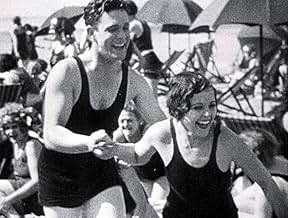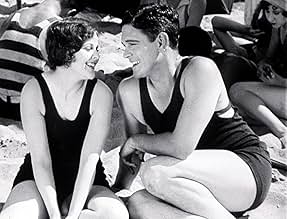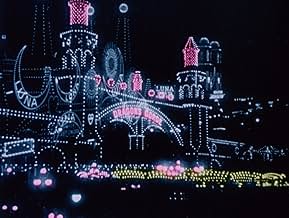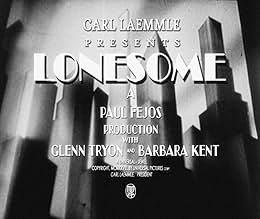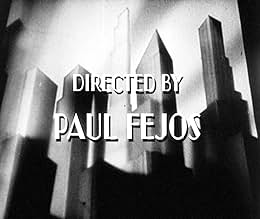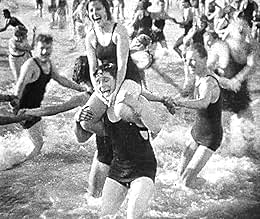PUNTUACIÓN EN IMDb
7,7/10
2,8 mil
TU PUNTUACIÓN
Añade un argumento en tu idiomaTwo lonely people in the big city meet and enjoy the thrills of an amusement park, only to lose each other in the crowd after spending a great day together. Will they ever see each other aga... Leer todoTwo lonely people in the big city meet and enjoy the thrills of an amusement park, only to lose each other in the crowd after spending a great day together. Will they ever see each other again?Two lonely people in the big city meet and enjoy the thrills of an amusement park, only to lose each other in the crowd after spending a great day together. Will they ever see each other again?
- Dirección
- Guión
- Reparto principal
- Premios
- 1 premio en total
Gusztáv Pártos
- Romantic Gentleman
- (as Gustav Partos)
Henry Armetta
- Ferris wheel guy
- (sin acreditar)
Edgar Dearing
- Cop
- (sin acreditar)
Louise Emmons
- Telephone Caller
- (sin acreditar)
Fred Esmelton
- Swami
- (sin acreditar)
Jack Raymond
- Barker
- (sin acreditar)
Churchill Ross
- Telephone Caller
- (sin acreditar)
Reseñas destacadas
... and I could say the same thing about Fejos' "Broadway", made a year later. Fejos recounts the tale of two lonely New Yorkers, Jim (Glen Tryon) and Mary (Barbara Kent), who find love and each other during a half day holiday at the beach and Coney Island. You first see the workday from Jim and Mary's perspective as they are ruled first by the tyranny of the alarm clock and then the tedium of the workday as you see a clock overlaying the image of each at work. Jim is a low-level machine operator, and Mary is a telephone operator. Then there are "the crowds". Jim and Mary are crowded at breakfast, at a diner filled with patrons, crowded on the subway, crowded at work, and crowded at the beach and amusement park. Yet both of them are completely alone in the world, which, especially in the attractive Miss Kent's case, seems somewhat inconceivable.
This late era silent has a dearth of title cards, which does not subtract from the film's enjoyment. In fact, what does subtract just a little are the short dialogue scenes that just don't make sense. One scene is Jim and Mary on the beach suddenly in the dark AND in color, with the crowd removed. Nothing they say shines any light on their situation or feelings at all. Another one is in a courtroom where Jim has been detained for being unruly. He gives a speech like a Bolshevik basically shaming the judge and ... the judge lets him go???? This social awareness seems very strange stuff coming from Jim who, up to that point, has seemed to be a very uncomplicated fellow. Very strange, but typical of talking scenes inserted into silent films at the dawn of sound.
What is extra special about this film is to see the lives of working class people in 1928. Notice that the workday that Jim and Mary are going through is a Saturday, and this was the norm back then and until some time after WWII. People would normally work half a day on Saturday and have only Sunday in its entirety as a day off. Catch this film if you can, even if you are not a huge silent film buff.
This late era silent has a dearth of title cards, which does not subtract from the film's enjoyment. In fact, what does subtract just a little are the short dialogue scenes that just don't make sense. One scene is Jim and Mary on the beach suddenly in the dark AND in color, with the crowd removed. Nothing they say shines any light on their situation or feelings at all. Another one is in a courtroom where Jim has been detained for being unruly. He gives a speech like a Bolshevik basically shaming the judge and ... the judge lets him go???? This social awareness seems very strange stuff coming from Jim who, up to that point, has seemed to be a very uncomplicated fellow. Very strange, but typical of talking scenes inserted into silent films at the dawn of sound.
What is extra special about this film is to see the lives of working class people in 1928. Notice that the workday that Jim and Mary are going through is a Saturday, and this was the norm back then and until some time after WWII. People would normally work half a day on Saturday and have only Sunday in its entirety as a day off. Catch this film if you can, even if you are not a huge silent film buff.
Lonesome is like the much more charming, if slightly less ambitious (and at the very end a bit too cute) cousin of Sunrise. It's appeal is in its simplicity, but where Sunrise was about a couple breaking apart and coming back together, this is much more streamlined and less tragic (though it does go for some tragic beats in the last twenty minutes of its slim 70-minute run-time): boy is lonely, girl is lonely, both work working-class jobs (factory/phone operator, what else in New York city in 1928?), they both decide separately after their (so-called!) friends go off on their own adventures to go to the beach and amusement park - is it Coney Island? I can't imagine it being anywhere else - and boy and girl meet as the boy tries to show off doing games. And that's it, that's the movie, and why it stands out (and got a sort-of restoration and Criterion treatment) is its presentation by its director.
I don't know much about Pal (Paul) Fejos except that he directed silent films and somewhat into the 1930's, and then sort of faded away into obscurity. It's a shame since a film like Lonesome shows his talents clearly: he has a keen sense of editing and that way that silent filmmakers sometimes had to super-impose images (perhaps a chip off the Abel Gance block perhaps, but not as ambitious), in particular when he's setting up the hustle/bustle of the city and then later in the film when things get more harrowing with the characters. That is to say when, inevitably, the main conflict is that they are separated in that great sea of people that makes up a massive crowd in a city (where, as the man, Jim, notes at one point, is so strange that you're surrounded by so many but still feel so alone).
The charm in the film comes in how the couple on screen - Barbara Kent and Glenn Tryon - are together; they're kind of like if you had one of those romantic "leads" in those really early Marx brothers movies, only they don't sing and the man is funny in that amusing- lightly- sarcastic way (i.e. bragging about his "six acres on Wall street" at first, which we and the girl knows isn't true, but it's fun to play along). Actually, speaking of that, this is an experimental film at heart for a number of reasons. It appears at first to be a silent film, and for 90% of it it surely is, and is shot like one with that film speed we associate with silent cinema on the whole (that kind of slightly-sped-up speed where its rhythm is distinctly of its cameras and era), and we know this because 10% of the film, more or less, is a *sound* film. No, really, we suddenly move from what is the obvious fluid camera style and wide shots of the crowds and intensity that comes with a camera that moves freely to what is clearly static shots in a studio so the actors are right under a microphone... and the acting is just as static.
That's not totally fair; this is considered, at least according to the trivia, one of the very first films to ever incorporate sound. On that level it's certainly extraordinary and important, but the problem is that it becomes jarring with the rest of the film which is shot with such passion and excitement (it's also frankly weird to hear the actor's speaking voices, whereas before, like I do with a lot of silent movies, I can think of my own voices for the actors that do not sound so... stilted). One of the sound scenes is also one where I wasn't sure if a cop was being sarcastic or not; our man Jim has been taken away by the cops after a roller-coaster ride where Mary, the girl, fainted and had to be taken away but Jim got separated and got rough with a cop. For a moment it seems like he'll be put away, but Jim pours his heart out (with some, I'm sorry, cringe-inducing lines), and the cop's reaction is hard to read since it sounds totally "pfft yeah right"... but then they let him go. Very strange.
But these aren't major complaints for a film that has so much to offer outside of those things. This is a movie that's joy is in its purity, that it's about these two people and how they meet and suddenly all of the usual problems of their everyday lives - the work, the drudgery, the intensity of being around so many people getting on/off the subways or being in the traffic - can float away since they have one another. And there are some moments of experimentation that do work, mostly involving (also, again, a touch of daring with Fejos) color: there's tinted scenes here, which isn't unusual for a silent film, but here it's how the colors are used, over the amusement park scenes to illuminate the lights at night, the performers in the park, the vibrancy that the night off a beach in the city brings.
There are so many moments of rich filmmaking, so much hope that this couple is able to inspire in a short amount of time, and because of the simplicity we're able to invest ourselves into their bond as it gets closer (maybe a little *too* quick, one might want to argue, falling in love within a day), that one can almost forgive a cutesy ending. Almost.
I don't know much about Pal (Paul) Fejos except that he directed silent films and somewhat into the 1930's, and then sort of faded away into obscurity. It's a shame since a film like Lonesome shows his talents clearly: he has a keen sense of editing and that way that silent filmmakers sometimes had to super-impose images (perhaps a chip off the Abel Gance block perhaps, but not as ambitious), in particular when he's setting up the hustle/bustle of the city and then later in the film when things get more harrowing with the characters. That is to say when, inevitably, the main conflict is that they are separated in that great sea of people that makes up a massive crowd in a city (where, as the man, Jim, notes at one point, is so strange that you're surrounded by so many but still feel so alone).
The charm in the film comes in how the couple on screen - Barbara Kent and Glenn Tryon - are together; they're kind of like if you had one of those romantic "leads" in those really early Marx brothers movies, only they don't sing and the man is funny in that amusing- lightly- sarcastic way (i.e. bragging about his "six acres on Wall street" at first, which we and the girl knows isn't true, but it's fun to play along). Actually, speaking of that, this is an experimental film at heart for a number of reasons. It appears at first to be a silent film, and for 90% of it it surely is, and is shot like one with that film speed we associate with silent cinema on the whole (that kind of slightly-sped-up speed where its rhythm is distinctly of its cameras and era), and we know this because 10% of the film, more or less, is a *sound* film. No, really, we suddenly move from what is the obvious fluid camera style and wide shots of the crowds and intensity that comes with a camera that moves freely to what is clearly static shots in a studio so the actors are right under a microphone... and the acting is just as static.
That's not totally fair; this is considered, at least according to the trivia, one of the very first films to ever incorporate sound. On that level it's certainly extraordinary and important, but the problem is that it becomes jarring with the rest of the film which is shot with such passion and excitement (it's also frankly weird to hear the actor's speaking voices, whereas before, like I do with a lot of silent movies, I can think of my own voices for the actors that do not sound so... stilted). One of the sound scenes is also one where I wasn't sure if a cop was being sarcastic or not; our man Jim has been taken away by the cops after a roller-coaster ride where Mary, the girl, fainted and had to be taken away but Jim got separated and got rough with a cop. For a moment it seems like he'll be put away, but Jim pours his heart out (with some, I'm sorry, cringe-inducing lines), and the cop's reaction is hard to read since it sounds totally "pfft yeah right"... but then they let him go. Very strange.
But these aren't major complaints for a film that has so much to offer outside of those things. This is a movie that's joy is in its purity, that it's about these two people and how they meet and suddenly all of the usual problems of their everyday lives - the work, the drudgery, the intensity of being around so many people getting on/off the subways or being in the traffic - can float away since they have one another. And there are some moments of experimentation that do work, mostly involving (also, again, a touch of daring with Fejos) color: there's tinted scenes here, which isn't unusual for a silent film, but here it's how the colors are used, over the amusement park scenes to illuminate the lights at night, the performers in the park, the vibrancy that the night off a beach in the city brings.
There are so many moments of rich filmmaking, so much hope that this couple is able to inspire in a short amount of time, and because of the simplicity we're able to invest ourselves into their bond as it gets closer (maybe a little *too* quick, one might want to argue, falling in love within a day), that one can almost forgive a cutesy ending. Almost.
8sb88
It's a shame Lonesome hasn't been seen more widely by modern audiences. The limited acclaim it's received is well deserved.
Lonesome is very simple. It's no more than a little romantic movie of two people who fall in love and then appear to lose each other. But the whole thing is told expertly well. The camera moves about freely in many unique and interesting ways. Visually alone, it's quite the spectacle. It also helps that the two in the lead roles are enjoyable.
Glenn Tyron is good enough in his lead role, but his romantic interest, played by Barbara Kent, is the real star. She is fun and playful when needed, but her soulful eyes convey more pain then most people ever could with their voices. Her charisma is evident from shot one.
The only downside to the film is the inclusion of a few sound scenes. Clearly done just to cash in on the new craze, it actually only serves to grind the story to a halt. It forces the movie to become stationary, and the dialogue itself is pretty inane.
I cannot recommend the film strongly enough, though. It's as enjoyable of a romance as you'll ever see. There's nothing too complicated here: just two people falling in love, and it's a joy to see.
Lonesome is very simple. It's no more than a little romantic movie of two people who fall in love and then appear to lose each other. But the whole thing is told expertly well. The camera moves about freely in many unique and interesting ways. Visually alone, it's quite the spectacle. It also helps that the two in the lead roles are enjoyable.
Glenn Tyron is good enough in his lead role, but his romantic interest, played by Barbara Kent, is the real star. She is fun and playful when needed, but her soulful eyes convey more pain then most people ever could with their voices. Her charisma is evident from shot one.
The only downside to the film is the inclusion of a few sound scenes. Clearly done just to cash in on the new craze, it actually only serves to grind the story to a halt. It forces the movie to become stationary, and the dialogue itself is pretty inane.
I cannot recommend the film strongly enough, though. It's as enjoyable of a romance as you'll ever see. There's nothing too complicated here: just two people falling in love, and it's a joy to see.
...that I cannot stand my own company...says the hero.
This could be the optimistic side of King Vidor's "the crowd".This era was a time when the pursuit of happiness was legitimate and "even with a face like that" you could hope to find the woman of your dreams.Robert Siodmak would make "Menschen Am Sonntag" and Marcel Carné "Nogent Eldorado Du Dimanche" soon after ,and would replace Coney Island by the banks of the Rhine or of the Seine.
1928 was the year before the crash .Even in the biggest city in the world ,you can be lonelier than the loneliest of creatures.He pretends he is a millionaire ,she pretends she is a princess ;in fact he is a working man,she is an operator .
It is not as optimistic as it seems at first sight.The crowds are hostile and do nothing to help them ,they are as selfish as today's crowds .
"Lonesome " is an important movie,if only for its simplicity and its spontaneity.Everything happens in the short space of one day (from the rude awakening to the night when solitude becomes even harder to bear ) and the two principals are really endearing ,almost matching Janet Gaynor and Charles Farrell.
NB:Paul Fejos would continue his career in France in the early thirties where he directed Annabella in a tragic melodrama ("Marie Legende Hongroise")and a remake of Feuillade's "Fantomas", the first third of which surpasses the original .
This could be the optimistic side of King Vidor's "the crowd".This era was a time when the pursuit of happiness was legitimate and "even with a face like that" you could hope to find the woman of your dreams.Robert Siodmak would make "Menschen Am Sonntag" and Marcel Carné "Nogent Eldorado Du Dimanche" soon after ,and would replace Coney Island by the banks of the Rhine or of the Seine.
1928 was the year before the crash .Even in the biggest city in the world ,you can be lonelier than the loneliest of creatures.He pretends he is a millionaire ,she pretends she is a princess ;in fact he is a working man,she is an operator .
It is not as optimistic as it seems at first sight.The crowds are hostile and do nothing to help them ,they are as selfish as today's crowds .
"Lonesome " is an important movie,if only for its simplicity and its spontaneity.Everything happens in the short space of one day (from the rude awakening to the night when solitude becomes even harder to bear ) and the two principals are really endearing ,almost matching Janet Gaynor and Charles Farrell.
NB:Paul Fejos would continue his career in France in the early thirties where he directed Annabella in a tragic melodrama ("Marie Legende Hongroise")and a remake of Feuillade's "Fantomas", the first third of which surpasses the original .
10Varlaam
This film is outstanding.
A man and woman leave their respective rented rooms for work. He's a "punch presser"; she's a switchboard operator. After work, neither one feels up to joining friends; they just feel too ... single. But they both head to Coney Island. They meet, fall in love, get separated, return home distressed. A plot that simple, even clichéd, does not appear to hold much promise.
But the energy! The pacing is so frenetic. There's constant movement on camera, clocks ticking, crowds scurrying, throngs crushing, machines stamping, carnivals, streamers, roller coaster rides. Moments of relative calm come when the lovers are together.
The thrilling impersonality of the urban maelstrom has hardly been better depicted. I came away thinking it was one of the best things I've seen.
If you've seen "The Devil and Miss Jones", the Jean Arthur / Robert Cummings comedy from 1941, then you can't help but remember the Coney Island beach scene where everyone is packed in together with barely room to move.
Well, this film has a scene just like that one. In fact, the greater part of the film is that way. You're never so alone as when you're in a crowd. These scenes are funny, but they do make their point.
I saw a restored print of "Solitude" (as it was titled) with colour tinting and three sound sequences, courtesy of Cinematheque Ontario. The sound segments are just awful, so typical of the very earliest sound, but perhaps they're a blessing in disguise. The extraordinary quality of the silent film is spotlighted by the awkwardness of these three brief scenes: Jim and Mary on the beach, Jim and Mary near the midway, Jim at the police station.
The ultimate restoration of this elusive marvel would make the film silent throughout, liberating it from the stylistic cacophony of the stilted sound sequences.
Neither lead performer, Barbara Kent nor Glenn Tryon, was known to me previously. (Andy Devine is plainly recognizable however.) It seems that Tryon later became the producer of "Hellzapoppin" and "Hold That Ghost". He also holds the only acting credit for a film that anyone at all seems to have seen, "Variety Girl" from 1947. To me, Barbara Kent resembles Paulette Goddard somewhat, while Glenn Tryon looks like a brother to Don DeFore and Bob Cummings.
The screening I attended was the Toronto première of the restoration. Let's hope it now becomes more widely available.
A man and woman leave their respective rented rooms for work. He's a "punch presser"; she's a switchboard operator. After work, neither one feels up to joining friends; they just feel too ... single. But they both head to Coney Island. They meet, fall in love, get separated, return home distressed. A plot that simple, even clichéd, does not appear to hold much promise.
But the energy! The pacing is so frenetic. There's constant movement on camera, clocks ticking, crowds scurrying, throngs crushing, machines stamping, carnivals, streamers, roller coaster rides. Moments of relative calm come when the lovers are together.
The thrilling impersonality of the urban maelstrom has hardly been better depicted. I came away thinking it was one of the best things I've seen.
If you've seen "The Devil and Miss Jones", the Jean Arthur / Robert Cummings comedy from 1941, then you can't help but remember the Coney Island beach scene where everyone is packed in together with barely room to move.
Well, this film has a scene just like that one. In fact, the greater part of the film is that way. You're never so alone as when you're in a crowd. These scenes are funny, but they do make their point.
I saw a restored print of "Solitude" (as it was titled) with colour tinting and three sound sequences, courtesy of Cinematheque Ontario. The sound segments are just awful, so typical of the very earliest sound, but perhaps they're a blessing in disguise. The extraordinary quality of the silent film is spotlighted by the awkwardness of these three brief scenes: Jim and Mary on the beach, Jim and Mary near the midway, Jim at the police station.
The ultimate restoration of this elusive marvel would make the film silent throughout, liberating it from the stylistic cacophony of the stilted sound sequences.
Neither lead performer, Barbara Kent nor Glenn Tryon, was known to me previously. (Andy Devine is plainly recognizable however.) It seems that Tryon later became the producer of "Hellzapoppin" and "Hold That Ghost". He also holds the only acting credit for a film that anyone at all seems to have seen, "Variety Girl" from 1947. To me, Barbara Kent resembles Paulette Goddard somewhat, while Glenn Tryon looks like a brother to Don DeFore and Bob Cummings.
The screening I attended was the Toronto première of the restoration. Let's hope it now becomes more widely available.
¿Sabías que...?
- CuriosidadesIt was one of the first motion pictures to have sound and a couple of talking scenes. It was released in both silent and monaural versions. Some scenes in existing original prints of the film are colored with stencils.
- Versiones alternativasProduced in both sound and silent versions. The sound version was 6,785 feet in length, and the silent version was 6,193 feet.
- ConexionesFeatured in Fejezetek a film történetéböl: Az amerikai film kezdetei (1989)
- Banda sonoraAlways
(uncredited)
Written by Irving Berlin
[Played by dance orchestra at ballroom]
Sung by Nick Lucas
[on Brunswick recording played in last scene]
Selecciones populares
Inicia sesión para calificar y añadir a tu lista para recibir recomendaciones personalizadas
- How long is Lonesome?Con tecnología de Alexa
Detalles
- Duración1 hora 9 minutos
- Mezcla de sonido
- Relación de aspecto
- 1.19:1
Contribuir a esta página
Sugerir un cambio o añadir el contenido que falta

Principal laguna de datos
By what name was Lonesome (1928) officially released in India in English?
Responde


